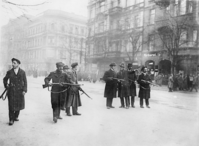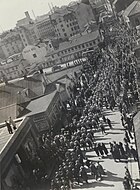Reykani Revolution of 1949
| Reykani Revolution of 1949 | |||||||
|---|---|---|---|---|---|---|---|
| |||||||
| Belligerents | |||||||
|
Communist revolutionaries:
|
| ||||||
| Commanders and leaders | |||||||
| Units involved | |||||||
| |||||||
| Strength | |||||||
|
10,000-50,000 16 tanks (captured) |
15,000 39 tanks | ||||||
| Casualties and losses | |||||||
| 3000-4000 | 2246 | ||||||
Reykani Revolution of 1949 (Reykani: Reykjanes byltingin 1949; Salisfordian: Rivoluzione Reicania del 1949), also known as the Utanvegar War, It takes its name from the Utanvegar trucks, primarily the Laugleós 500 series, used to provide mobility for the revolutionary and colonial troops as they fought againts eachother, and as technicals, was an countrywide revolution that started on 3 January 1949 against the government of the Grand Duchy of Reykanes(1781-1949) and the policies caused by the government's subordination to Salisford. The revolution lasted 5 months before the Salisfordian backed Grand Duchy was defeated and pushed out to the White Islands, west of the island and the revolutionary factions won the revolution. Between all the factions, the communists got on the top. The Reykani Socialist Republic was the first modern independent country on the island.
The Reykani Revolution started on 3 January 1949 in Laugleós at a workers strike, which led to a tension with the military police, that started a full on revolution. Some factions organized in to militias to fight against the Grand Duchy as well. After 5 months of fighting, the revolutionary faction won. One side demanded a election, which took place but many parties weren't allowed to take part. As a reaction a fascist party established the Reykani State in June 1949 but it was quickly taken over by the Communist Faction.
Background
The Grand Duchy of Reykanes was a colony of the Kingdom of Salisford and maintained an administration roughly modeled on the Salisfordian government. A nascent industrial working class resented the government for doing too little to protect them, as it banned strikes and organizing into labor unions. Underground parties didn't receive rights or any representation in Reykanes. A Nationalist side was also present in fueling the revolution, as they were minimal laws protecting Reykani culture and language.
Uprising and revolution
On 3 Janury 1949 Kári Jónsson organizes a workers strike in the morning at a car factory in Laugleós. Sympathy strikes in other parts of the city raised the number of strikers as well. This was apart of multiple strikes that occurred since the start of the decade. After being told to dissolve the strike, the protestors took radical routes. Some factories were closed down by them and didn't leave till their demands were accepted. By late afternoon the protestors marched to the capitol building of the city. The troops guarding the building were ordered to tell the demonstrators not to pass a certain point but at a point, troops opened fire on the demonstrators, causing 50-60 deaths. This became known as the "Bloody Afternoon". The country was filled with protests all around. The protests were initally nationalistic as well. After this the demands expanded as more and more people joined, like various underground parties joined the cause. Demands now included stopping the Salisfordinazation of the country and to abandon the monarchy. The KFR supported by "Petrov Boys" a paramilitary group of the party took over the factory and seized some Laugleós 500 series trucks and then proceeded to take over a radio station in the city to broadcast their demands. The local militia moved in to stop the uprising, however due to the huge size of the protestors and increased size of the "Petrov Boys", they were pushed back and the capitol building was captured as well.
The Salisfordian administration didn’t want to fully mobilize the entire military for a colonial rebellion, so an intervention by Salisford was limited. They hoped that the rebellion can be quickly solved by the local colonial troops. The uprising in Hafnir and other bigger cities were crushed by the end of the month and martial law was enacted. On 6 February 1949, the Reykani Socialist Republic was established. They conducted mostly guerilla warfare and attacked from the mountains, which put a strain on the colonial forces. Communist activity involved capturing weaponry and freeing prisoners, meanwhile many Reykani soldiers switched sides. Till April, the guerilla warfare was successful, where most of South East Reykanes was under the communists, The Grand Duchy slowly lost the rural country side, however they still remained a tough oppononent, having the means of production and using weapons, which the other factions didn't have access to and even bombed the de-facto capital of the Reykani Socialist Republic on 30 February 1949, killing about 11 citizens and 2 revolutionary soldiers and destroying more than 6 buildings, however this only happened once during the Revolution. Fascist paramilitary forces "Greyshirts", were present in South Western Reykanes since January and conducted guerilla warfare as well throughout the revolution. Democratic parties like TBD, organized protests around the country every month but their activities were quickly stopped as well and also resulted in partisan activities, their biggest violent protest was on 2 June till 7 June 1949 in the streets of Hafnir to oppose the martial law. The communist faction took their chance and marched towards Hafnir to join the protestors. The streets in the city quickly turned violent, the revolutionaries compromised of armed militias and the Communist army, which fought the soldiers and tanks of the Grand Duchy and eventually won the battle. It was one of the most brutal urban combat in the revolution. The leadership of the Grand Duchy was disposed of after the red army took over the capital building, however the Governor-general Alfonso Broddason, managed to leave the country and traveled to Salisford.
The rest of the army escaped to the north to form a counter attack, however all their efforts were futile. The Communists started a offensive in the northern regions on the following days. Due to the difficult terrain, the colonial forces managed to escape to the White Islands and set up camp, after which the war ended on 12 June 1949. Due to the lack of a navy for the Communists, they never managed to invade the island.
Aftermath
After the revolution ended a power struggle occurred, between the winner factions. The communists were the most powerful due to their size of their army but in the following month resistance grew against them. As a means of getting power and due to pressure from the multiple opposing sides and by other countries like Quebeschire, and with a fear of a possible intervention, a election was held in early July 1949. The Reykani Communist Party consolidated its power in the interim using salami tactics. A hospital cought fire in Hafnir, which the Communists attributed the fire to the Fascist agitators, as a result they couldn't take part in the election, which the communists managed to win, but they also rigged it. As a response, the Nationalist Party established the Reykani State in southern Reykanes in July. The State was short lived, only existing for 34 days, after the creation of the state, the Communists invaded it, starting the 34-Day War. A week after the start of the war and gaining power, the government started the Red Terror. The Red Terror in Reykanes was a period of repressive violence and suppression carried out by the Reykani Communist Party, primarily towards anti-communist forces, and others deemed "enemies of the state".
After the end of the revolution, the state nationalised all companies and established a planned economy system in the country. Massive victory marches were conducted around the country.









